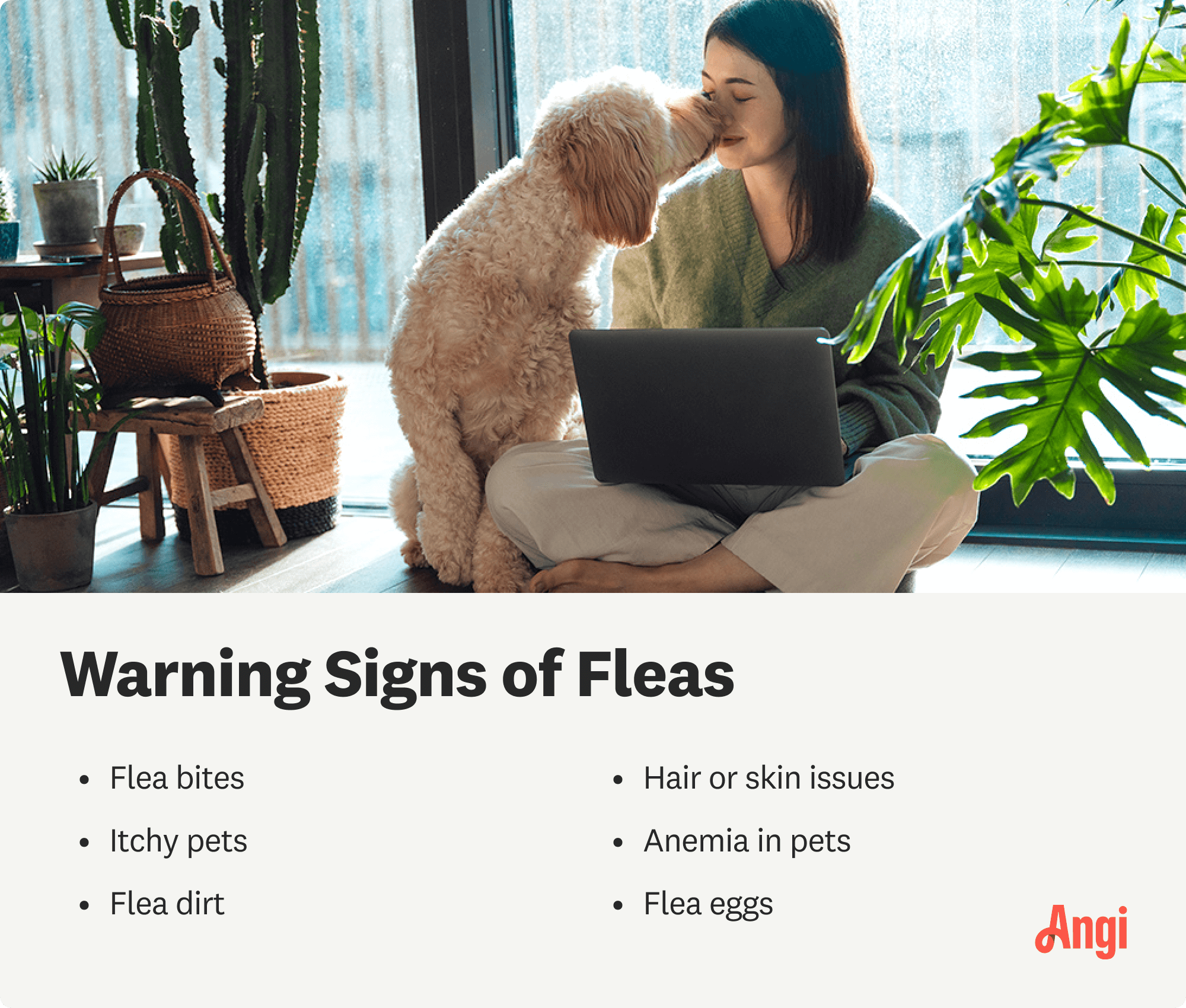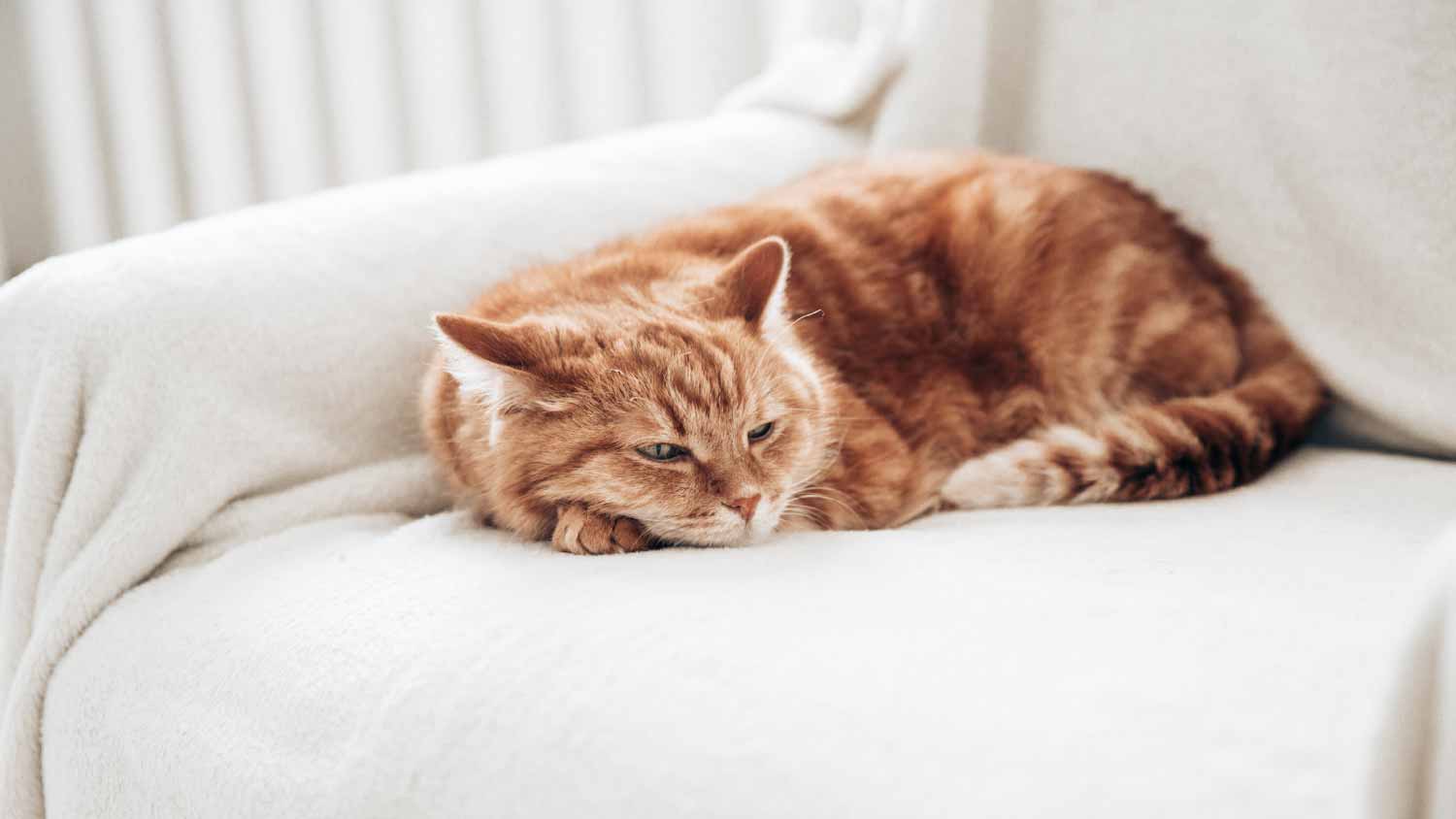
Whether you have bugs, bats, or rodents invading your home, you’ll want to contact an exterminator quickly. Find out how much pest control costs in Columbus, OH.
Yes, they can—which is why it’s important to get rid of them ASAP


Fleas are tiny bugs that can live in your furniture, carpet, bedding, and linens.
Fleas in your furniture can be treated through vacuuming, steam cleaning, and applying pet flea treatment.
You can prevent a flea infestation by cleaning your flooring, furniture, and linens regularly, plus keeping the bugs off of your pets.
If you have pets or grew up with them, you’ve likely encountered a flea or two. Despite their size, fleas are no small threat to animals and humans. But can fleas live on your furniture?
Since fleas can carry and transmit diseases, you should take any evidence of a flea infestation seriously. If you spot one or more fleas or have red, swollen bites that itch like crazy, you may need to try the treatment steps listed below or contact a pest control specialist for further help.

Fleas are small insects that survive by feeding on the blood of animals or humans. They are wingless, oval-shaped bugs that are light to dark brown and about 2 to 8 millimeters long, depending on the species. They have six legs with larger hind legs that enable them to jump from surface to surface.
Fleas leave behind red, itchy bites that can develop within 30 minutes of being bitten. These pesky bites can often swell and turn into a blister or small wound. Although they may seem harmless, fleas can transmit diseases from one host to another, making them a threat to household pets like dogs and cats and their owners. These tiny insects can pass on anything from tapeworm larvae to flea-borne typhus, which is why identifying and treating them as soon as they’re spotted is a must.
Yes! Once fleas attach themselves to you or your pets and come inside your home, they can also burrow into upholstered furniture. And that’s not the only place they can infest. Fleas can live in your carpet, bedding, or pet beds, and they often lay their eggs there as well. If this happens, you can get rid of fleas in your carpet by vacuuming, steam cleaning, shampooing, and spreading diatomaceous earth, boric acid, or flea powder in the fibers.
Although adult fleas may only last about a week on your couch, they can lay thousands of eggs, turning your comfy TV watching spot into a bug-infested zone. On the upside, you can eliminate the insects by trying natural home remedies or calling a local pest control company.
One of the most common ways fleas get on furniture and other areas of your home is from pets. They can burrow into your pet’s bed or surrounding carpet, and then spread to other furniture or areas of your home. Fleas can jump eight inches off the ground, so getting onto your couch is no problem, even if you don’t allow your pets on it.
However, it may not even be your pet's fault that fleas have infested your home. They can actually hitch a ride on your shoes and clothing, too. Fleas can also get on furniture if you have a pest problem, as mice and rats can carry fleas into your house.

You can take several steps to get rid of fleas in your home, starting with removing any linens on your bed, upholstered furniture, or pet beds. Wash these linens in hot water with detergent, killing the fleas and their eggs. After this step, you should vacuum your furniture, the carpet, and any other areas the fleas may have contacted. Using a steamer on your upholstered furniture is also a good idea, and if you don’t own a steamer, they’re usually available to rent from your local hardware store.
Another way to ensure fleas stay far away from your furniture is to keep them off your animals. Flea shampoo or other over-the-counter flea treatments can help get fleas out of your animals’ fur. Take a trip to the vet for oral prescription medications for serious infestations.
According to the Centers for Disease Control (CDC), the best way to prevent fleas from entering your home is to regularly clean the flooring, linens, and furniture. The more diligent you are in cleaning the areas your pets frequent, the less fleas can lay their eggs and stick around. Vacuuming carpets and rugs, sweeping floors, and washing bedding regularly in hot water and detergent effectively keep fleas at bay.
To prevent fleas on your pets, you should regularly check their fur for fleas, and brush and bathe them weekly. Other ways to prevent fleas from finding their way on your pets is to limit their exposure to stray or wild animals and use flea control products recommended by your veterinarian.
If you go the DIY route, treating fleas at home will likely cost less than $100, especially if you own equipment like a vacuum and steamer. However, if you’d rather be safe than sorry, professional flea extermination costs anywhere from $75 to $400, depending on the extent of the infestation and the type of treatment used.
When you hire a flea control expert, they’ll likely perform an initial inspection that costs a flat rate of $75 to $100. Once they come up with a treatment plan for your space, they’ll likely vacuum and steam clean before applying a treatment around the exterior of your home. If the infestation is extreme, they may need to fumigate your home to ensure the bugs and any of their eggs are gone for good.
This company does it right. Firstly, I want to say that Landan was a joy to work with. He was so kind, transparent, and had everything under control. His entire team showed up ready to work and they were all very respectful of the fact that we were in an office space. A little backstory – we...
Our office has a new lease on life, thanks to Custom Paint Jobs LLC. Outstanding work!
Window Depot did an amazing job on my deck. I wasnt sure what I wanted to do, but their composite decking was affordable and will last a long time. I am excited to have family over, and I am no longer embarrassed by my backyard. Jeff and the ground crew were polite, respectful, and caring for...
Storms Mobile Welding was great to work with. They were prompt, professional and did an overall excellent job on the project. I highly recommend.
AFS was excellent from start to finish. Jess, the sales associate, was fantastic...very knowledgeable and very professional. The installation crew was excellent. I couldn't be more pleased with the process. Best of all, my new floor looks fantastic!
We used Unique Hardwood Floor LLC three years ago to work on the floors of a 70 year old home that needed a great deal of work. Some floors needed repairs, some were replaced and others just needed to be refinished. It was a complicated job as they needed to blend the old and the new to...
While Naaman and Mike were very professional and amicable to work with, there were issues in this project that makes giving a higher rating impossible. We had several communications issues that delayed completion. The roofers accessed the property without communicating with me. Just showed up...
Mr. Pooner's company came out gave us an estimate and promised installation within 10 weeks from receipt of signed contract and deposit. Mr. Pooner obtained all the necessary licenses and began work promptly. His company's workmanship is excellent. The garage door is mounted on steel...
My 2nd floor furnace was only working sporadically and the warranty company sent Air Fast to fix the issue. They came out and shut off the furnace completely. Said they would be back the next day when they had a new flame sensor... 4 more days passed with me calling them multiple times a day...
They called 15 minutes before arrival to announce that they were coming and arrived on time. Immediately they saw the broken springs and replaced them very quickly. Jeff suggest that I put on a rope to the manual switch to operate it more easily if necessary. I explained that my old door...
From average costs to expert advice, get all the answers you need to get your job done.

Whether you have bugs, bats, or rodents invading your home, you’ll want to contact an exterminator quickly. Find out how much pest control costs in Columbus, OH.

Moth infestations can cause damage to items in your home. Learn how much moth extermination costs and ways to save in this informative guide.

When calculating the cost of hiring a flea exterminator, consider your home size and the infestation extent. This guide will help you figure out what to budget.

Learn who to hire to exterminate mosquitos, compare mosquito extermination and pest control, and see how pros work. Get clear steps to choose with confidence.

Your pets may pick up fleas in the yard and spread them through the house. Learn how to get rid of fleas in your yard to treat the problem at its source.

Nobody wants to tangle with wasps on their property, as these insects sting with extreme prejudice. Here’s how to get rid of wasps safely and for good.